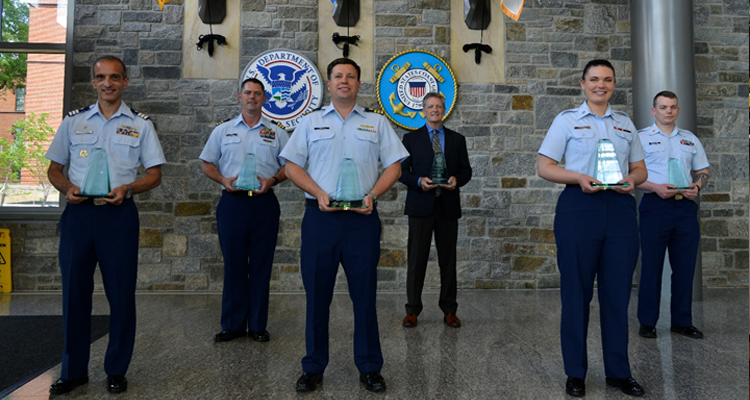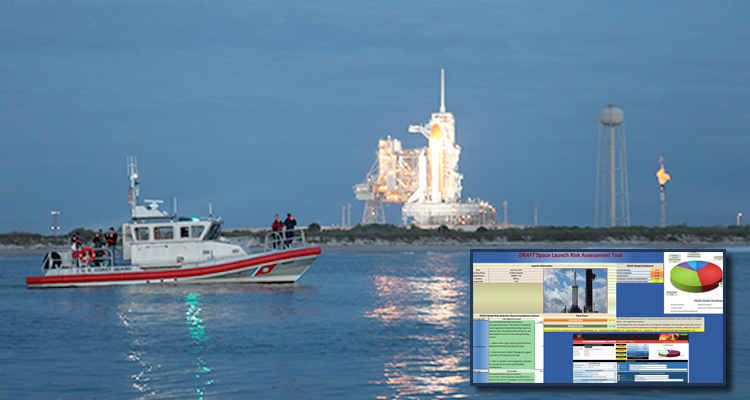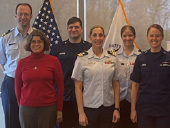May 12, 2021 —

Representing the winners in each category of the 2020 Capt. Niels P. Thomsen Innovation Awards are, from left, Auxiliarist Alvaro Ferrando, Cmdr. Joel Carse, Cmdr. Baxter Smoak, Douglas Campbell, Petty Officer 3rd Class Kristin Talbott and Petty Officer 1st Class James Lenkiewicz.
The Coast Guard recognized a group of exceptional innovators with Capt. Niels P. Thomsen Innovation Awards during the Senior Leadership Conference held April 30, 2021, at Coast Guard Headquarters.
This year, five of the six winning initiatives involved technology. “It’s an increasingly technological domain, with things constantly changing around us,” commented Adm. Karl Schultz, Coast Guard commandant, who presented the awards. “And if we don’t innovate into that, we don’t keep our edge and won’t be the world’s best Coast Guard.”
The key factor, however, is what each of the winning initiatives brings to the service. “While this year’s winners are working in technological spaces and computer-based systems, they’re really about practical solutions that affect Coast Guard operations that really enhance our ability to do the mission,” Schultz said.
Vice Adm. Michael McAllister, deputy commandant for mission support and master of ceremonies, told the audience of Coast Guard senior leaders that these awards prove that the answers to many of the Coast Guard’s challenges can be found at the deckplate level. “What we have here is a group of folks who have really focused their talents on innovation and did the hard work to put in place some creativity that has moved Coast Guard missions forward.”
The annual awards recognize innovative efforts by the Coast Guard workforce to increase efficiency or productivity or provide other process improvements. Their namesake is considered a legendary Coast Guard innovator; the chain stopper Thomsen developed in 2008 was credited with dramatically improving the safety of buoy tending operations for the Coast Guard. Thirty-seven projects/ideas were considered for the 2020 awards.
This year’s winners:
Science or Technology

CHAINLENK (inset screen capture) uses data to change the focus from quantity of boardings to more targeted boardings in the fight against illegal, unreported and unregulated fishing.
CHAINLENK: Countering Illegal, Unreported and Unregulated (IUU) Fishing with Data Driven Solutions: District 17 Intelligence Branch – Petty Officer 1st Class James Lenkiewicz and Lt. Emily Johnson.

CHAINLENK is a data compilation tool used to optimize targeting of suspected IUU fishing and human rights violators on the high seas. This tool uses indicators of illicit activity to assign a violation probability to each vessel and displays them by characteristics indicating illegal activity.
CHAINLENK was created in support of Operation North Pacific Guard, a D17-sponsored annual operation. Its use and the increasingly advanced intelligence-driven approach to enforcement operations directly resulted in the identification of 14 violations on foreign fishing vessels and uncovered new efforts by foreign-flagged fishing vessels to evade law enforcement.
Operations or Readiness

A boatcrew from Station Port Canaveral, Florida, supports a launch. The inset shows screen captures of Space Launch Risk Assessment Tool data.
Commercial Space Launch Risk Assessment Tool (SLRAT): Sector Jacksonville Space Launch Innovation Team – Douglas Campbell, Petty Officer 1st Class Dionysios Mitsios, Lt. Emily Sysko, Lt. LaMarcus Walker, Cmdr. Scott Kirkland, Cmdr. Joshua Rose, Cmdr. Jillian Lamb, Lt. Cmdr. Molly Keyser, Lt. Anthony Scott, Lt. Joel Hill and Chief Petty Officer Robert Martin.

In the wake of the continuing expansion of the commercial space industry, Sector Jacksonville’s Space Innovation Team identified the need to standardize how the Coast Guard supports and responds to the risks associated with commercial space operation in the maritime domain, specifically in marine safety, maritime security, environmental protection and vessel compliance. SLRAT quantifies inherent risk, suggests pre-determined mitigation strategies and recommends force laydowns to reduce overall risk for each launch event.
Since creation, SLRAT has been used for more than 40 commercial space launches, including the first two crewed commercial space launch operations in U.S. history in May and November 2020. This tool standardizes risk across space operators, incorporates best practices from historical data and provides fleet-wide risk mitigation support to operational commanders in support of dynamic space operations. As space operations have evolved, the team created a follow-on tool that continues to assess risk for commercial space re-entry missions and has since merged the two to create the Space Operational Assessment of Risk for Launch and Re-Entry.
Administration, Training or Support

In response to COVID-19 restrictions, 10 legacy courses were converted to facilitated online learning to ensure Coast Guard shore forces was properly trained to execute some of the service’s most dynamic mission sets.
Modernized Learning for Shore Forces Readiness: Response Training Branch at Training Center Yorktown – Cmdr. Joel Carse, Mark Ogle, Kristy Plourde, Lt. Cmdr. Paul Simpson, Lt. Jeremy Leggett, Lt. Cmdr. John Laraia, Lt. Cmdr. Michael Oubre, Lt. Mark Bender, Lt. Elizabeth Tatum.

The Response Training Branch at Training Center Yorktown trains all members of the operations ashore community; pre-COVID this encompassed 26 courses spanning 195 resident, exportable and international meetings for 4,500 students annually. Additionally, the Response Training Branch performs 23 Command Center Standardize visits and three National Strike Team Ready for Operations assessments in support of the National Coordination Center each year.
In response to the COVID-19 pandemic, 10 legacy courses were converted to an advanced distributed learning format and a virtual assessment capability was implemented to ensure Coast Guard-wide workforce performance and mission readiness. This pioneering initiative established the most effective transformation to modernized ready learning and saw the conversion of 38 percent of the response training branch’s suite of resident courses to facilitated online training. A remote knowledge and performance assessment process for 47 command centers and three national strike teams was also developed.
Culture Change
Urination Device for Female Boat Crewmembers: Petty Officer 3rd Class Kristin Talbott.

To help female crewmembers improve performance and eliminate health risks, Talbott suggested providing urination devices to female crewmembers for field missions. This idea has since been implemented through inclusion in the Rescue and Survival Systems Manual.
Auxiliary Achievement

Flyers advertising some of the online training available through Sector Miami.
Uninspected Passenger Vessel (UPV) and Bareboat Charters Remote Education & Outreach Actions: Auxiliarist Alvaro Ferrando.

Adapting to challenges posed by COVID-19, Sector Miami leveraged Commercial Virtual Remote and Microsoft Teams to continue offering online training workshops and owner/operator small group discussions to educate law enforcement personnel and ensure continued engagement with the public. There are currently six online products – from workshops to Q&A events in both English and Spanish – to keep the maritime industry informed and educated. An example product is "How to Pass Your UPV Examination," a three-hour online workshop to help the audience prepare for a future, traditional face-to-face examination.
Cmdr. Joel Magnussen Innovation Award for Management

Starting Jan. 1, 2021, Coast Guard marine inspectors across the country started using the new small passenger vessel risk-based inspection regime developed using the Adaptive Risk Model for Inspected Small Passenger Vessels.
Adaptive Risk Model for Inspected Small Passenger Vessels (SPV): Small Passenger Vessel Safety Task Force – Capt. Matt Edwards, Cmdr. Baxter Smoak, Lt. Cmdr. Timothy McNamara, Lt. Cmdr. Brian Crimmel, Lt. Cmdr. Kevin Kinsella, and Emanuel Terminella Jr. (not pictured).

Following two tragic major marine casualties claiming 51 passenger lives, the SPV Safety Task Force leveraged machine learning and subject matter expert input to create an adaptable, quantitative analysis tool that reliably identifies the key drivers of marine casualties and calculates a risk score for each vessel within the largest segment of the U.S.-inspected fleet. Follow-on policy efforts set the required scope and frequency of inspection; a minimum competency of the lead inspector; and the level of accountability for each vessel.
In addition to their modeling and policy efforts, this team conducted extensive education and outreach with the field, district and area commands to aid adoption and foster implementation. Their efforts directly improved marine inspector allocation, targeted risk and enhanced the governance necessary to increase passenger safety across the country.

Additional team members, from left, Lt. Cmdr. Peter Bizzaro, Juliet Hudson, Lt. Cmdr. Matthew Meacham, Lt. Cmdr. Stefanie Hodgdon, Lt. Kimberly Gates and Lt. Katherine Ahrens. Not pictured: Lt. Matthew Zanella, Lt. Cmdr. Jeff Bybee, Lt. Cmdr. Cameron Cooper, Lt. Cmdr. Keith Heine, Jennifer Poythress and Marc Cruder.
Related:

Video: Top 6 Coast Guard Innovations of 2020
For information on Coast Guard R&D: Research, Development, Test and Evaluation program page and Innovation program page